Modern Approaches in the Discovery and Development of Plant-Based Natural Products and Their Analogues as Potential Therapeutic Agents
Abstract
:1. Introduction
2. Selection of Plants for Screening
2.1. Selection Based on Ethnopharmacological Knowledge
2.2. Random Approach
2.3. Approach Based on Traditional System of Medicine
3. Authentication of Plant
4. Extraction and Isolation of Natural Compounds Using Biological-Activity Guided Fractionation
4.1. Parallel Approach
4.1.1. Extraction
4.1.2. Fractionation
4.1.3. Isolation and Purification
4.2. Sequential Approach
4.2.1. Extraction and Fractionation
4.2.2. Isolation and Purification
4.3. Some Recent Experiment Using Bio-Activity-Guided Fractionation Technique
5. Structure Elucidation of Isolated Compounds
6. Biological Screening of Extracts/Fraction/Isolates
Target-Based vs. Phenotype Screening Approaches
7. Molecular Modeling and Natural Product Database
7.1. In-Silico Ligand Construction and Preparation
7.2. Target Preparation
7.3. Docking
7.4. Identification of Hit Molecule
7.5. Optimization of Hits
8. Bioactivity-Guided Fractionation Approach–Challenges and Advances
8.1. Identification of Bioactive Constituents
8.2. Identification of Synergists
9. Conclusions
Author Contributions
Funding
Institutional Review Board Statement
Informed Consent Statement
Data Availability Statement
Conflicts of Interest
References
- Newman, D.J.; Cragg, G.M.; Snader, K.M. The influence of natural products upon drug discovery. Nat. Prod. Rep. 2000, 17, 215–234. [Google Scholar] [PubMed] [Green Version]
- Newman, D.J.; Cragg, G.M.; Snader, K.M. Natural products as sources of new drugs over the period 1981–2002. J. Nat. Prod. 2003, 66, 1022–1037. [Google Scholar] [CrossRef] [PubMed]
- Koehn, F.E.; Carter, G.T. The evolving role of natural products in drug discovery. Nat. Rev. Drug Discov. 2005, 4, 206–220. [Google Scholar] [CrossRef] [PubMed]
- Balunas, M.J.; Kinghorn, A.D. Drug discovery from medicinal plants. Life Sci. 2005, 78, 431–441. [Google Scholar] [CrossRef]
- Drahl, C.; Cravatt, B.F.; Sorensen, E.J. Protein-reactive natural products. Angew. Chem. Int. Ed. Engl. 2005, 44, 5788–5809. [Google Scholar] [CrossRef]
- Chin, Y.W.; Balunas, M.J.; Chai, H.B.; Kinghorn, A.D. Drug Discovery From Natural Sources. AAPS J. 2006, 8, 28. [Google Scholar] [CrossRef] [Green Version]
- Grifo, F.; Newman, D.; Fairfield, A.; Bhattacharya, B.; Grupenhoff, J. The origins of prescription drugs. In Biodiversity and Human Health; Grifo, F., Rosenthal, J., Eds.; Island Press: Washington, DC, USA, 1997; pp. 131–163. [Google Scholar]
- Patridge, E.; Gareiss, P.; Kinch, M.S.; Hoyer, D. An analysis of FDA-approved drugs: Natural products and their derivatives. Drug Discov. Today 2016, 21, 204–207. [Google Scholar] [CrossRef]
- De la Torre, B.G.; Albericio, F. The Pharmaceutical Industry in 2018. An Analysis of FDA Drug Approvals from the Perspective of Molecules. Molecules 2019, 24, 809. [Google Scholar] [CrossRef] [Green Version]
- Butler, M.S. The role of natural product chemistry in drug discovery. J. Nat. Prod. 2004, 67, 2141–2153. [Google Scholar] [CrossRef]
- Oberlies, N.H.; Kroll, D.J. Camptothecin and taxol: Historic achievements in natural products research. J. Nat. Prod. 2004, 67, 129–135. [Google Scholar] [CrossRef]
- Calixto, J.B. The role of natural products in modern drug discovery. An. Da Acad. Bras. De Ciências 2019, 91, e20190105. [Google Scholar] [CrossRef]
- Cragg, M.G.; Newman, D.J.; Snader, K.M. Natural products in drug discovery and development. J. Nat. Prod. 1997, 60, 52–60. [Google Scholar] [CrossRef]
- Harvey, A. Strategies for discovering drugs from previously unexplored natural products. Drug Disc. Today 2000, 5, 294–299. [Google Scholar] [CrossRef]
- Strohl, W.R. The role of natural products in a modern drug discovery program. Drug Disc. Today 2000, 5, 39–41. [Google Scholar] [CrossRef]
- Newman, D.J.; Cragg, G.M. Natural products as sources of new drugs from 1981 to 2014. J. Nat. Prod. 2016, 79, 629–661. [Google Scholar] [CrossRef] [Green Version]
- Li, J.W.; Vederas, J.C. Drug discovery and natural products: End of an era or an endless frontier? Science 2009, 325, 161–165. [Google Scholar] [CrossRef] [Green Version]
- Katiyar, C.; Gupta, A.; Kanjilal, S.; Katiyar, S. Drug discovery from plant sources: An integrated approach. AYU 2012, 33, 10–19. [Google Scholar] [CrossRef]
- Patwardhan, B.; Vaidya, A.D.; Chorghade, M. Ayurveda and natural product drug discovery. Curr. Sci. 2004, 86, 789–799. [Google Scholar]
- Fabricant, D.S.; Farnsworth, N.R. The value of plants used in traditional medicine for drug discovery. Environ. Health Perspect. 2001, 109 (Suppl. 1), 69–75. [Google Scholar]
- Lone, S.H.; Bhat, K.A.; Khuroo, M.A. Arglabin: From isolation to antitumor evaluation. Chem. Biol. Interact. 2015, 240, 180–198. [Google Scholar] [CrossRef]
- Adekenov, S.M.; Muchametzhanov, M.N.; Kagarlitskii, A.D.; Kuprianov, A.N. Arglabin—A new sesquiterpene lactone from Artemisia glabella. Chem. Nat. Compd. 1982, 18, 623–624. [Google Scholar] [CrossRef]
- Meshnick, S.R. Artemisinin: Mechanisms of action, resistance and toxicity. Int. J. Parasitol. 2002, 32, 1655–1660. [Google Scholar] [CrossRef]
- Huestis, M.A.; Solimini, R.; Pichini, S.; Pacifici, R.; Carlier, J.; Busardò, F.P. Cannabidiol Adverse Effects and Toxicity. Curr. Neuropharmacol. 2019, 17, 974–989. [Google Scholar] [CrossRef]
- Sharma, S.K.; Vij, A.S.; Sharma, M. Mechanisms and clinical uses of capsaicin. Eur. J. Pharmacol. 2013, 720, 55–62. [Google Scholar] [CrossRef]
- Dalbeth, N.; Lauterio, T.J.; Wolfe, H.R. Mechanism of action of colchicine in the treatment of gout. Clin. Ther. 2014, 36, 1465–1479. [Google Scholar] [CrossRef] [Green Version]
- Hewlings, S.J.; Kalman, D.S. Curcumin: A Review of Its Effects on Human Health. Foods 2017, 6, 92. [Google Scholar] [CrossRef]
- Steinmann, J.; Buer, J.; Pietschmann, T.; Steinmann, E. Anti-infective properties of epigallocatechin-3-gallate (EGCG), a component of green tea. Br. J. Pharmacol. 2013, 168, 1059–1073. [Google Scholar] [CrossRef] [Green Version]
- Min, K.J.; Kwon, T.K. Anticancer effects and molecular mechanisms of epigallocatechin-3-gallate. Integr. Med. Res. 2014, 3, 16–24. [Google Scholar] [CrossRef] [PubMed] [Green Version]
- Razay, G.; Wilcock, G.K. Galantamine in Alzheimer’s disease. Expert Rev. Neurother. 2008, 8, 9–17. [Google Scholar] [CrossRef] [PubMed]
- Tuli, H.S.; Tuorkey, M.J.; Thakral, F.; Sak, K.; Kumar, M.; Sharma, A.K.; Sharma, U.; Jain, A.; Aggarwal, V.; Bishayee, A. Molecular mechanisms of action of genistein in cancer: Recent advances. Front. Pharmacol. 2019, 10, 1336. [Google Scholar] [CrossRef] [PubMed] [Green Version]
- Neghab, H.K.; Goliaei, B. Therapeutic potential of gossypol: An overview. Pharm. Biol. 2014, 52, 124–128. [Google Scholar] [CrossRef]
- Stockfleth, E.; Bastian, M. Pharmacokinetic and pharmacodynamic evaluation of ingenol mebutate for the treatment of actinic keratosis. Expert Opin. Drug Metab. Toxicol. 2018, 14, 911–918. [Google Scholar] [CrossRef]
- Ferraz da Costa, D.C.; Pereira Rangel, L.; Martins-Dinis, M.M.D.D.C.; Ferretti, G.D.D.S.; Ferreira, V.F.; Silva, J.L. Anticancer potential of resveratrol, β-lapachone and their analogues. Molecules 2020, 25, 893. [Google Scholar] [CrossRef] [Green Version]
- Gong, Q.; Hu, J.; Wang, P.; Li, X.; Zhang, X. A comprehensive review on β-lapachone: Mechanisms, structural modifications, and therapeutic potentials. Eur. J. Med. Chem. 2021, 210, 112962. [Google Scholar] [CrossRef]
- Atanasov, A.G.; Waltenberger, B.; Pferschy-Wenzig, E.M.; Linder, T.; Wawrosch, C.; Uhrin, P.; Temml, V.; Wang, L.; Schwaiger, S.; Heiss, E.H.; et al. Discovery and resupply of pharmacologically active plant-derived natural products: A review. Biotechnol. Adv. 2015, 33, 1582–1614. [Google Scholar] [CrossRef] [Green Version]
- Yakhni, M.; Briat, A.; El Guerrab, A.; Furtado, L.; Kwiatkowski, F.; Miot-Noirault, E.; Cachin, F.; Penault-Llorca, F.; Radosevic-Robin, N. Homoharringtonine, an approved anti-leukemia drug, suppresses triple negative breast cancer growth through a rapid reduction of anti-apoptotic protein abundance. Am. J. Cancer Res. 2019, 9, 1043–1060. [Google Scholar]
- Horwitz, S.B. Taxol (paclitaxel): Mechanisms of action. Ann. Oncol. 1994, 5 (Suppl. 6), S3–S6. [Google Scholar]
- Ardalani, H.; Avan, A.; Ghayour-Mobarhan, M. Podophyllotoxin: A novel potential natural anticancer agent. Avicenna. J. Phytomed. 2017, 7, 285–294. [Google Scholar]
- Anand David, A.V.; Arulmoli, R.; Parasuraman, S. Overviews of biological importance of quercetin: A bioactive flavonoid. Pharmacogn. Rev. 2016, 10, 84–89. [Google Scholar] [CrossRef] [Green Version]
- Hussein, M.; Karas, J.A.; Schneider-Futschik, E.K.; Chen, F.; Swarbrick, J.; Paulin, O.K.A.; Hoyer, D.; Baker, M.; Zhu, Y.; Li, J.; et al. The killing mechanism of teixobactin against methicillin-resistant Staphylococcus aureus: An untargeted metabolomics study. mSystems 2020, 5, e00077–20. [Google Scholar] [CrossRef]
- Maloney, K.N.; Macmillan, J.B.; Kauffman, C.A.; Jensen, P.R.; Dipasquale, A.G.; Rheingold, A.L.; Fenical, W. Lodopyridone, a structurally unprecedented alkaloid from a marine actinomycete. Org. Lett. 2009, 11, 5422–5424. [Google Scholar] [CrossRef] [PubMed] [Green Version]
- Feling, R.H.; Buchanan, G.O.; Mincer, T.J.; Kauffman, C.A.; Jensen, P.R.; Fenical, W. Salinosporamide A: A highly cytotoxic proteasome inhibitor from a novel microbial source, a marine bacterium of the new genus salinospora. Angew. Chem. Int. Ed. Engl. 2003, 42, 355–357. [Google Scholar] [CrossRef] [PubMed]
- Peterson, R.M.; Huang, T.; Rudolf, J.D.; Smanski, M.J.; Shen, B. Mechanisms of self-resistance in the platensimycin- and platencin-producing Streptomyces platensis MA7327 and MA7339 strains. Chem. Biol. 2014, 21, 389–397. [Google Scholar] [CrossRef] [PubMed] [Green Version]
- Weiss, C.; Figueras, E.; Borbely, A.N.; Sewald, N. Cryptophycins: Cytotoxic cyclodepsipeptides with potential for tumor targeting. J. Pept. Sci. 2017, 23, 514–531. [Google Scholar] [CrossRef]
- Miller, W.R.; Bayer, A.S.; Arias, C.A. Mechanism of action and resistance to daptomycin in Staphylococcus aureus and Enterococci. Cold Spring Harb. Perspect. Med. 2016, 6, a026997. [Google Scholar] [CrossRef] [Green Version]
- Jones, R.N.; Fritsche, T.R.; Sader, H.S.; Ross, J.E. Activity of retapamulin (SB-275833), a novel pleuromutilin, against selected resistant gram-positive cocci. Antimicrob. Agents Chemother. 2006, 50, 2583–2586. [Google Scholar] [CrossRef] [Green Version]
- Cragg, G.M.; Newman, D.J. Natural products: A continuing source of novel drug leads. Biochim. Et Biophys. Acta BBA Gen. Subj. 2013, 1830, 3670–3695. [Google Scholar] [CrossRef] [Green Version]
- Klayman, D.L.; Lin, A.J.; Acton, N.; Scovill, J.P.; Hoch, J.M.; Milhous, W.K.; Theoharides, A.D.; Dobek, A.S. Isolation of artemisinin (qinghaosu) from Artemisia annua growing in the United States. J. Nat. Prod. 1984, 47, 715–717. [Google Scholar] [CrossRef]
- Smille, T.J.; Khan, I.A. A Comprehensive approach to identifying and authenticating botanical products. Clin. Pharm. Therap. 2010, 87, 175–186. [Google Scholar] [CrossRef]
- Lau, P.W.; Peng, Y.; Zhao, Z.Z. Microscopic identification of Chinese patent medicine Wu Zi Yan Zong Wan. J. Nat. Med. 2004, 58, 258–265. [Google Scholar]
- Zhao, Z.Z.; Shimomura, H.; Sashida, Y.; Tujino, R.; Ohamoto, T.; Kazami, T. Identification of traditional Chinese patent medicine by polariscope (1): Polariscopic Characteristics of starch grains and calcium oxalate crystals. Nat. Med. 1996, 50, 389–398. [Google Scholar]
- Liang, Z.T.; Jiang, Z.H.; Leing, K.S.Y.; Peng, Y.; Zhao, Z.L. Distinguishing the medicinal herb Oldenlandia diffusa from similar species of the same genus using fluorescence microscopy. Microsc. Res. Tech. 2006, 69, 277–282. [Google Scholar] [CrossRef]
- Baralcat, H.H.; Sahar Hussin, A.M.; Mohamed Marzouk, S.; Merfort, I.; Linscheid, M.; Nawwar Mohamed, A.M. Polyphenolic metabolities of Epilobium hirsutisam. Phytochemistry 1997, 46, 935–941. [Google Scholar]
- Liang, Y.Z.; Xie, P.; Chan, K. Quality control of herbal medicines. J. Chromatogr. B 2004, 812, 53–70. [Google Scholar] [CrossRef]
- Raclariu, A.C.; Heinrich, M.; Ichim, M.C.; de Boer, H. Benefits and limitations of DNA barcoding and metabarcoding in herbal product authentication. Phytochem. Anal. 2018, 29, 123–128. [Google Scholar] [CrossRef]
- Techen, N.; Parveen, I.; Pan, Z.; Khan, I.A. DNA barcoding of medicinal plant material for identification. Curr. Opin. Biotechnol. 2014, 25, 103–110. [Google Scholar] [CrossRef]
- De Boer, H.J.; Ichim, M.C.; Newmaster, S.G. DNA barcoding and pharmacovigilance of herbal medicines. Drug Saf. 2015, 38, 611–620. [Google Scholar] [CrossRef]
- Heinrich, M.; Anagnostou, S.; Tschirch, A.; Anagnostou, S.; Blaschek, W.; Wichtl, M.; Phillipson, J.D.; Bohlin, L.; Göransson, U.; Backlund, A.; et al. From pharmacognosia to DNA-based medicinal plant authentication–pharmacognosy through the centuries. Planta Med. 2017, 4, 37–47. [Google Scholar] [CrossRef]
- Sgamma, T.; Lockie-Williams, C.; Kreuzer, M.; Williams, S.; Scheyhing, U.; Koch, E.; Slater, A.; Howard, C. DNA barcoding for industrial quality assurance. Planta Med. 2017, 83, 1117–1129. [Google Scholar] [CrossRef] [Green Version]
- Nothias, L.F.; Nothias-Esposito, M.; da Silva, R.; Wang, M.; Ivan Protsyuk, I.; Zhang, Z.; Sarvepalli, A.; Pieter Leyssen, P.; Touboul, D.; Costa, J.; et al. Bioactivity-based molecular networking for the discovery of drug leads in natural product bioassay-guided fractionation. J. Nat. Prod. 2018, 81, 758–767. [Google Scholar] [CrossRef] [Green Version]
- Shams Eldin, S.M.; Radwan, M.M.; Wanas, A.S.; Habib, A.M.; Kassem, F.F.; Hammoda, H.M.; Khan, S.I.; Klein, M.L.; Elokely, K.M.; ElSohly, M.A. Bioactivity-guided isolation of potential antidiabetic and antihyperlipidemic compounds from Trigonella stellata. J. Nat. Prod. 2018, 81, 1154–1161. [Google Scholar] [CrossRef]
- Kinghorn, A.D. The discovery of drugs from higher plants. In The Discovery of Natural Products with Therapeutic Potential; Gullo, V.P., Ed.; Butterworth-Heinemann: Oxford, UK, 1994; pp. 81–108. [Google Scholar]
- Tu, P.C.; Chan, C.J.; Liu, Y.C.; Kuo, Y.H.; Lin, M.K.; Lee, M.S. Bioactivity-Guided Fractionation and NMR-Based Identification of the Immunomodulatory Isoflavone from the Roots of Uraria crinita (L.) Desv. ex DC. Foods 2019, 8, 543. [Google Scholar] [CrossRef] [Green Version]
- Michel, C.; El-sherei, M.; Islam, W.; Sleem, A.; Ahmed, S. Bioactivity-guided fractionation of the stem bark extract of Pterocarpus dalbergioides Roxb. ex Dc growing in Egypt. Bull. Fac. Pharm. Cairo Univ. 2013, 51, 1–5. [Google Scholar] [CrossRef] [Green Version]
- Iqbal, D.; Khan, M.S.; Khan, M.S.; Ahmad, S.; Hussain, M.S.; Ali, M. Bioactivity guided fractionation and hypolipidemic property of a novel HMG-CoA reductase inhibitor from Ficus virens Ait. Lipids Health Dis. 2015, 14, 15. [Google Scholar] [CrossRef] [Green Version]
- Abdallah, M.S.; Mustafa, M.; Nallappan, M.A.; Choi, S.; Paik, J.H.; Rusea, G. Determination of phenolics and flavonoids of some useful medicinal plants and bioassay-guided fractionation substances of Sclerocarya birrea (A. Rich) Hochst stem (bark) extract and their efficacy against Salmonella typhi. Front. Chem. 2021, 9, 670530. [Google Scholar] [CrossRef]
- Baldé, M.A.; Tuenter, E.; Matheeussen, A.; Traoré, M.S.; Cos, P.; Maes, L.; Camara, A.; Diallo, M.S.T.; Baldé, E.S.; Balde, A.M.; et al. Bioassay-guided isolation of antiplasmodial and antimicrobial constituents from the roots of Terminalia albida. J. Ethnopharmacol. 2021, 267, 113624. [Google Scholar] [CrossRef]
- Lee, S.R.; Lee, S.; Moon, E.; Park, H.J.; Park, H.B.; Kim, K.H. Bioactivity-guided isolation of anti-inflammatory triterpenoids from the sclerotia of Poria cocos using LPS-stimulated Raw264.7 cells. Bioorg. Chem. 2017, 70, 94–99. [Google Scholar] [CrossRef]
- Sarkhail, P.; Navidpour, L.; Rahimifard, M.; Hosseini, N.M.; Souri, E. Bioassay-guided fractionation and identification of wound healing active compound from Pistacia vera L. hull extract. J. Ethnopharmacol. 2020, 248, 112335. [Google Scholar] [CrossRef] [PubMed]
- Suekaew, N.; Na Pombejra, S.; Kulsing, C.; Doungchawee, J.; Khotavivattana, T. Bioassay-guided fractionation, chemical compositions and antibacterial activity of extracts from rhizomes of Globba schomburgkii Hook.f. Chem. Biodivers. 2020, 17, e2000173. [Google Scholar] [CrossRef] [PubMed]
- Rolta, R.; Kumar, V.; Sourirajan, A.; Upadhyay, N.K.; Dev, K. Bioassay guided fractionation of rhizome extract of Rheum emodi wall as bio-availability enhancer of antibiotics against bacterial and fungal pathogens. J. Ethnopharmacol. 2020, 257, 112867. [Google Scholar] [CrossRef] [PubMed]
- El Deeb, K.S.; Eid, H.H.; Ali, Z.Y.; Shams, M.M.; Elfiky, A.M. Bioassay-guided fractionation and identification of antidiabetic compounds from the rind of Punica Granatum Var. nana. Nat. Prod. Res. 2021, 35, 2103–2106. [Google Scholar] [CrossRef]
- Daud, M.N.H.; Wibowo, A.; Abdullah, N.; Ahmad, R. Bioassay-guided fractionation of Artocarpus heterophyllus L. J33 variety fruit waste extract and identification of its antioxidant constituents by TOF-LCMS. Food Chem. 2018, 266, 200–214. [Google Scholar] [CrossRef]
- Harvey, A.L. Medicines from nature: Are natural products still relevant to drug discovery? Trends Pharmacol. Sci. 1999, 20, 196–198. [Google Scholar] [CrossRef]
- Hughes, D. New HTS imaging technology deal. Drug Discov. Today 1998, 3, 438–439. [Google Scholar] [CrossRef]
- Lawrence, R.N. Rediscovering natural product biodiversity. Drug Discov. Today 1999, 4, 449–451. [Google Scholar] [CrossRef]
- Harvey, A.L. Natural products as a screening resource. Curr. Opin. Chem. Biol. 2007, 11, 480–484. [Google Scholar] [CrossRef]
- Wu, S.; Yang, L.; Gao, Y.; Liu, X.; Liu, F. Multi-channel counter-current chromatography for high-throughput fractionation of natural products for drug discovery. J. Chromatogr. A 2007, 1180, 99–107. [Google Scholar] [CrossRef]
- Singh, S.B.; Barrett, J.F. Empirical antibacterial drug discovery– foundation in natural products. Biochem. Pharmacol. 2006, 71, 1006–1015. [Google Scholar] [CrossRef]
- Quinn, R.J.; Carroll, A.R.; Pham, N.B.; Baron, P.; Palframan, M.E.; Suraweera, L.; Pierens, G.K.; Muresan, S. Developing a drug-like natural product library. J. Nat. Prod. 2008, 71, 464–468. [Google Scholar] [CrossRef]
- Gray, A.I.; Igoli, J.O.; Edrada-Ebel, R. Natural products isolation in modern drug discovery programs. In Natural Products Isolation, Methods in Molecular Biology; Sarker, S.D., Nahar, L., Eds.; Humana Press: Totowa, NJ, USA, 2012; Volume 864, pp. 515–534. [Google Scholar] [CrossRef]
- Hamid, R.; Rotshteyn, Y.; Rabadi, L.; Parikh, R.; Bullock, P. Comparison of alamar blue and MTT assays for high through-put screening. Toxicol. In Vitro 2004, 18, 703–710. [Google Scholar] [CrossRef]
- Coats, P.; Kennedy, S.; Pyne, S.; Wainwright, C.L.; Wadsworth, R.M. Inhibition of non-Ras protein farnesylation reduces in-stent restenosis. Atherosclerosis 2008, 197, 515–523. [Google Scholar] [CrossRef] [PubMed]
- O’Brien, P.; Haskins, J.R. In vitro cytotoxicity assessment. Methods Mol. Biol. 2007, 356, 415–425. [Google Scholar] [PubMed]
- Freshney, R.I. Culture of Animal Cells: A Manual of Basic Techniques; Wiley-Blackwell: Hoboken, NJ, USA, 2010. [Google Scholar]
- Liska, D.J. The detoxification enzyme systems. Altern. Med. Rev. 1998, 3, 187–198. [Google Scholar] [PubMed]
- Kell, D. Screensavers: Trends in high-throughput analysis. Trends Biotechnol. 1999, 17, 89–91. [Google Scholar] [CrossRef]
- Sittampalam, G.S.; Kahl, S.D.; Janzen, W.P. High-throughput screening: Advances in assay technologies. Curr. Opin. Chem. Biol. 1997, 1, 384–391. [Google Scholar] [CrossRef]
- Sundberg, S.A. High-throughput and ultra-high-throughput screening: Solution- and cell-based approaches. Curr. Opin. Biotechnol. 2000, 11, 47–53. [Google Scholar] [CrossRef]
- Houston, J.G.; Banks, M. The chemical–biological interface: Developments in automated and miniaturized screening technology. Curr. Opin. Biotechnol. 1997, 8, 734–740. [Google Scholar] [CrossRef]
- Moffat, J.G.; Vincent, F.; Lee, J.A.; Eder, J.; Prunotto, M. Opportunities and challenges in phenotypic drug discovery: An industry perspective. Nat. Rev. Drug Discov. 2017, 16, 531–543. [Google Scholar] [CrossRef]
- Swinney, D.C. Phenotypic vs. target-based drug discovery for first-in-class medicines. Clin. Pharmacol. Ther. 2013, 93, 299–301. [Google Scholar] [CrossRef]
- Chatterjee, A.K.; Yeung, B.K. Back to the future: Lessons learned in modern target-based and whole-cell lead optimization of antimalarials. Curr. Top. Med. Chem. 2012, 12, 473–483. [Google Scholar] [CrossRef] [Green Version]
- Gamo, F.J.; Sanz, L.M.; Vidal, J.; de Cozar, C.; Alvarez, E.; Lavandera, J.L.; Vanderwall, D.E.; Green, D.V.S.; Kumar, V.; Hasan, S.; et al. Thousands of chemical starting points for antimalarial lead identification. Nature 2010, 465, 305–310. [Google Scholar] [CrossRef]
- Swinney, D.C.; Anthony, J. How were new medicines discovered? Nat. Rev. Drug Discov. 2011, 10, 507–519. [Google Scholar] [CrossRef]
- Kitchen, D.B.; Decornez, H.; Furr, J.R.; Bajorath, J. Docking and scoring in virtual screening for drug discovery: Methods and applications. Nat. Rev. Drug Discov. 2004, 3, 935–949. [Google Scholar] [CrossRef]
- Sorokina, M.; Steinbeck, C. Review on natural products databases: Where to find data in 2020. J. Cheminform. 2020, 12, 20. [Google Scholar] [CrossRef] [Green Version]
- Liao, C.; Sitzmann, M.; Pugliese, A.; Nicklaus, M.C. Software and resources for computational medicinal chemistry. Future Med. Chem. 2011, 3, 1057–1085. [Google Scholar] [CrossRef] [Green Version]
- Chen, G.; Seukep, A.J.; Guo, M. Recent advances in molecular docking for the research and discovery of potential marine drugs. Mar. Drugs. 2020, 18, 545. [Google Scholar] [CrossRef]
- Devillers, J. Methods for building QSARs. Methods Mol. Biol. 2013, 930, 3–27. [Google Scholar]
- Sullivan, K.M.; Manuppello, J.R.; Willett, C.E. Building on a solid foundation: SAR and QSAR as a fundamental strategy to reduce animal testing. SAR QSAR Environ. Res. 2014, 25, 357–365. [Google Scholar] [CrossRef]
- Stockwell, B.R. Exploring biology with small organic molecules. Nature 2004, 432, 846–854. [Google Scholar] [CrossRef] [Green Version]
- Bindseil, K.U.; Jakupovic, J.; Wolf, D.; Lavayre, J.; Leboul, J.; van der Pyl, D. Pure compound libraries; a new perspective for natural product based drug discovery. Drug Discov. Today 2001, 6, 840–847. [Google Scholar] [CrossRef]
- Inui, T.; Wang, Y.; Pro, S.M.; Franzblau, S.G.; Pauli, G.F. Unbiased evaluation of bioactive secondary metabolites in complex matrices. Fitoterapia 2012, 83, 1218–1225. [Google Scholar] [CrossRef] [Green Version]
- Wang, M.; Carver, J.J.; Phelan, V.V.; Sanchez, L.M.; Garg, N.; Peng, Y.; Nguyen, D.D.; Watrous, J.; Kapono, C.A.; Luzzatto-Knaan, T.; et al. Sharing and community curation of mass spectrometry data with Global Natural Products Social Molecular Networking. Nat. Biotechnol. 2016, 34, 828–837. [Google Scholar] [CrossRef] [Green Version]
- Caesar, L.K.; Cech, N.B. Synergy and antagonism in natural product extracts: When 1 + 1 does not equal 2. Nat. Prod. Rep. 2019, 36, 869–888. [Google Scholar] [CrossRef] [Green Version]
- Junio, H.A.; Sy-Cordero, A.A.; Ettefagh, K.A.; Burns, J.T.; Micko, K.T.; Graf, T.N.; Richter, S.J.; Cannon, R.E.; Oberlies, N.H.; Cech, N.B. Synergy-directed fractionation of botanical medicines: A case study with goldenseal (Hydrastis canadensis). J. Nat. Prod. 2011, 74, 1621–1629. [Google Scholar] [CrossRef] [Green Version]
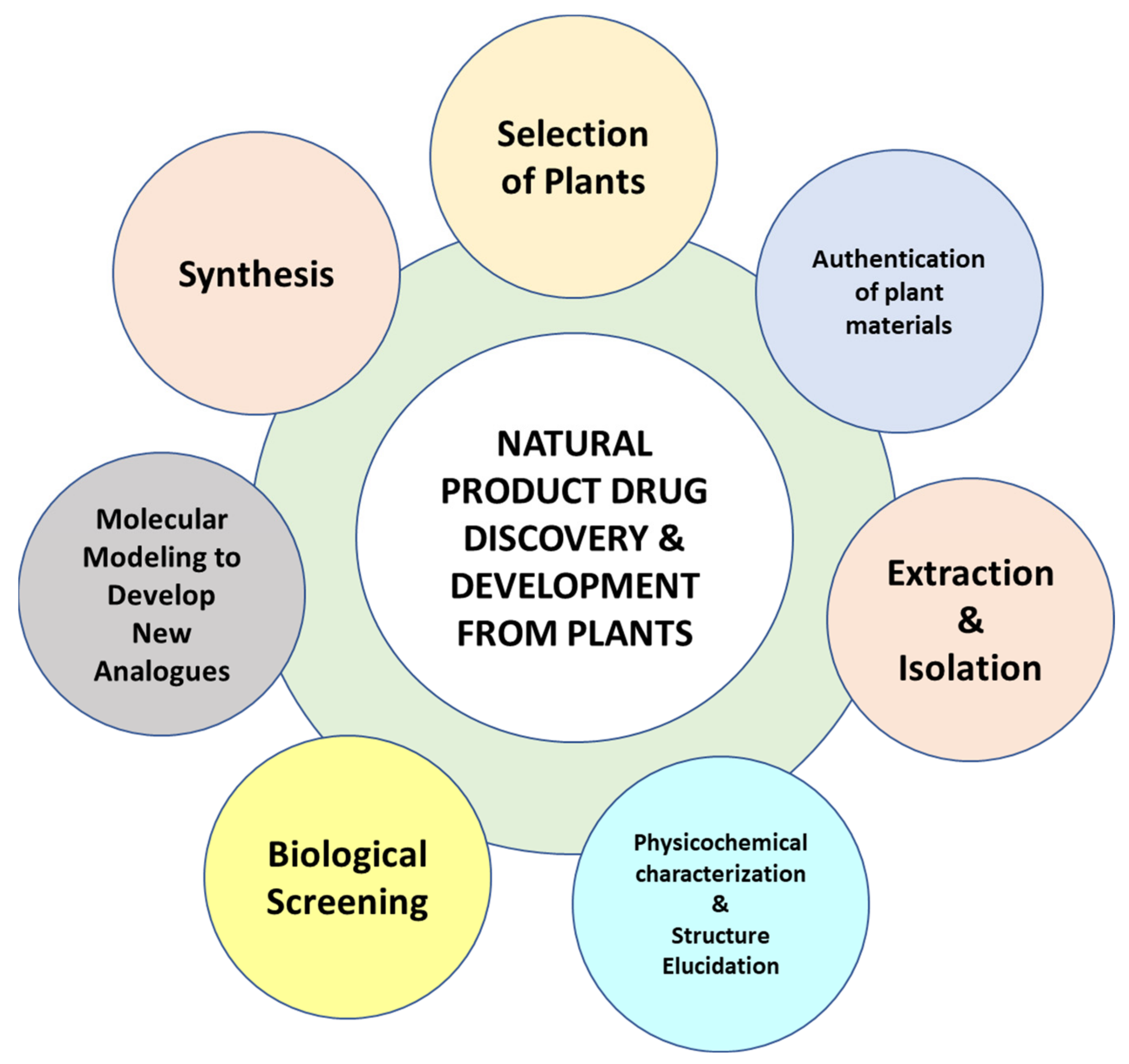

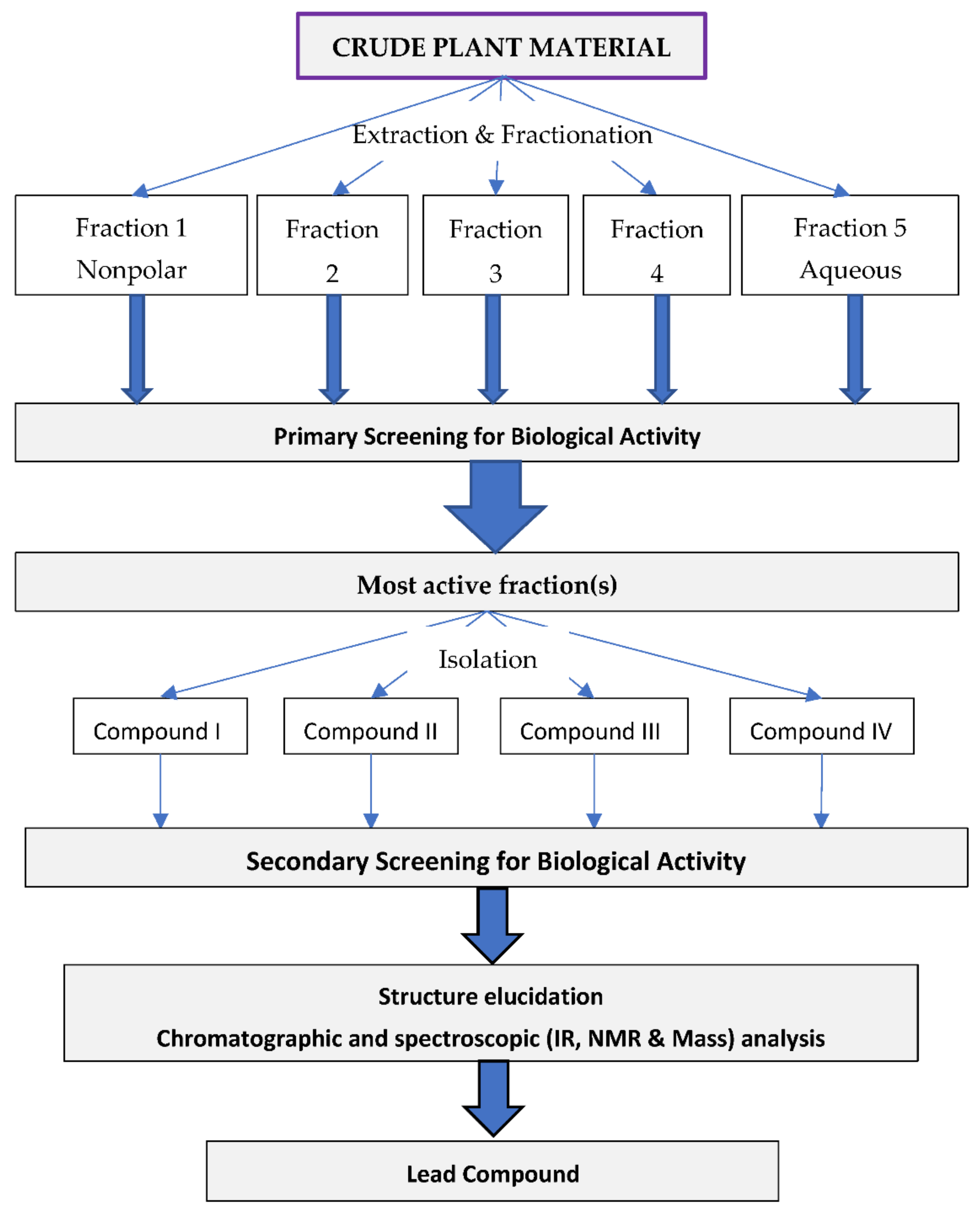
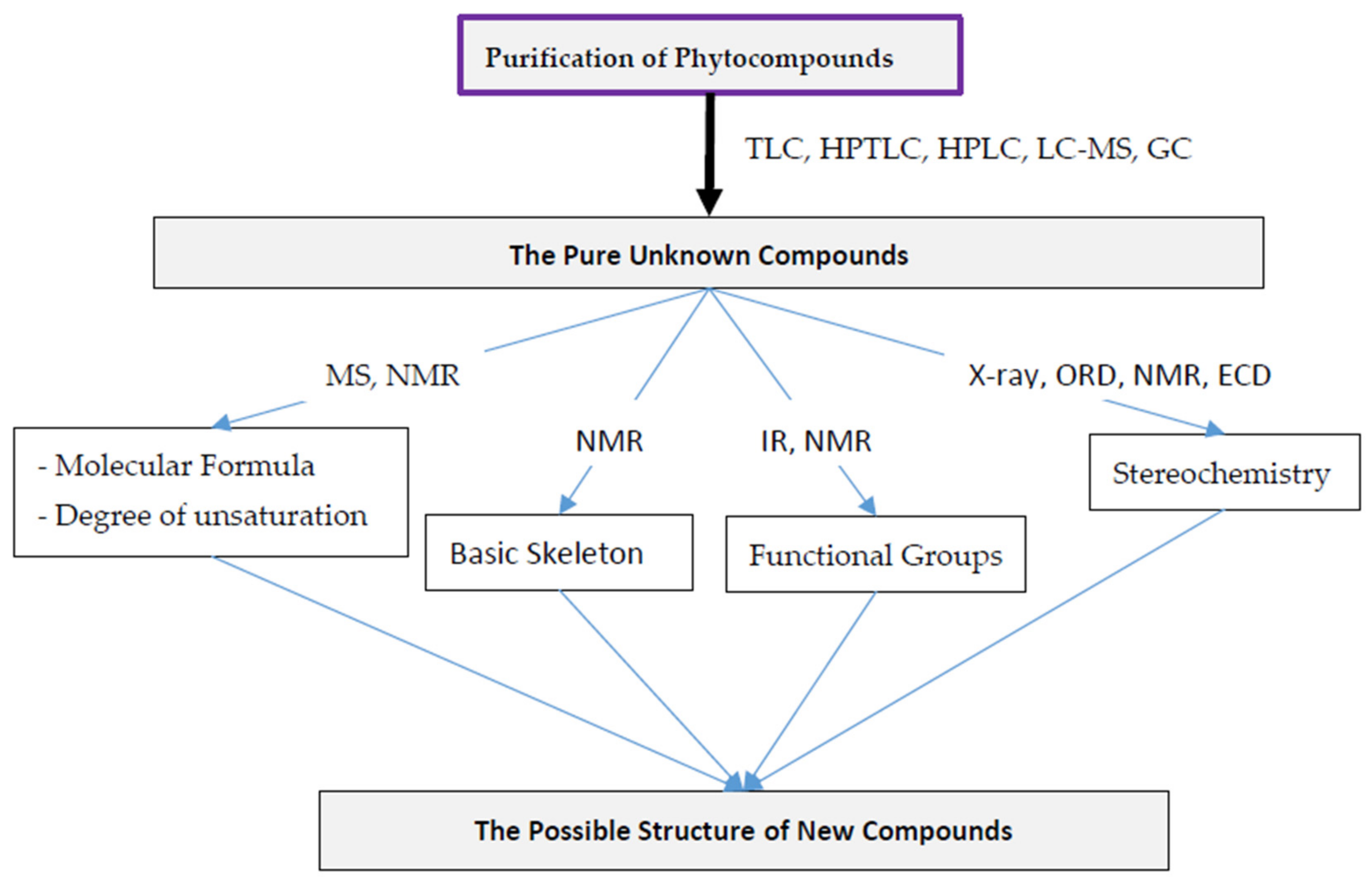
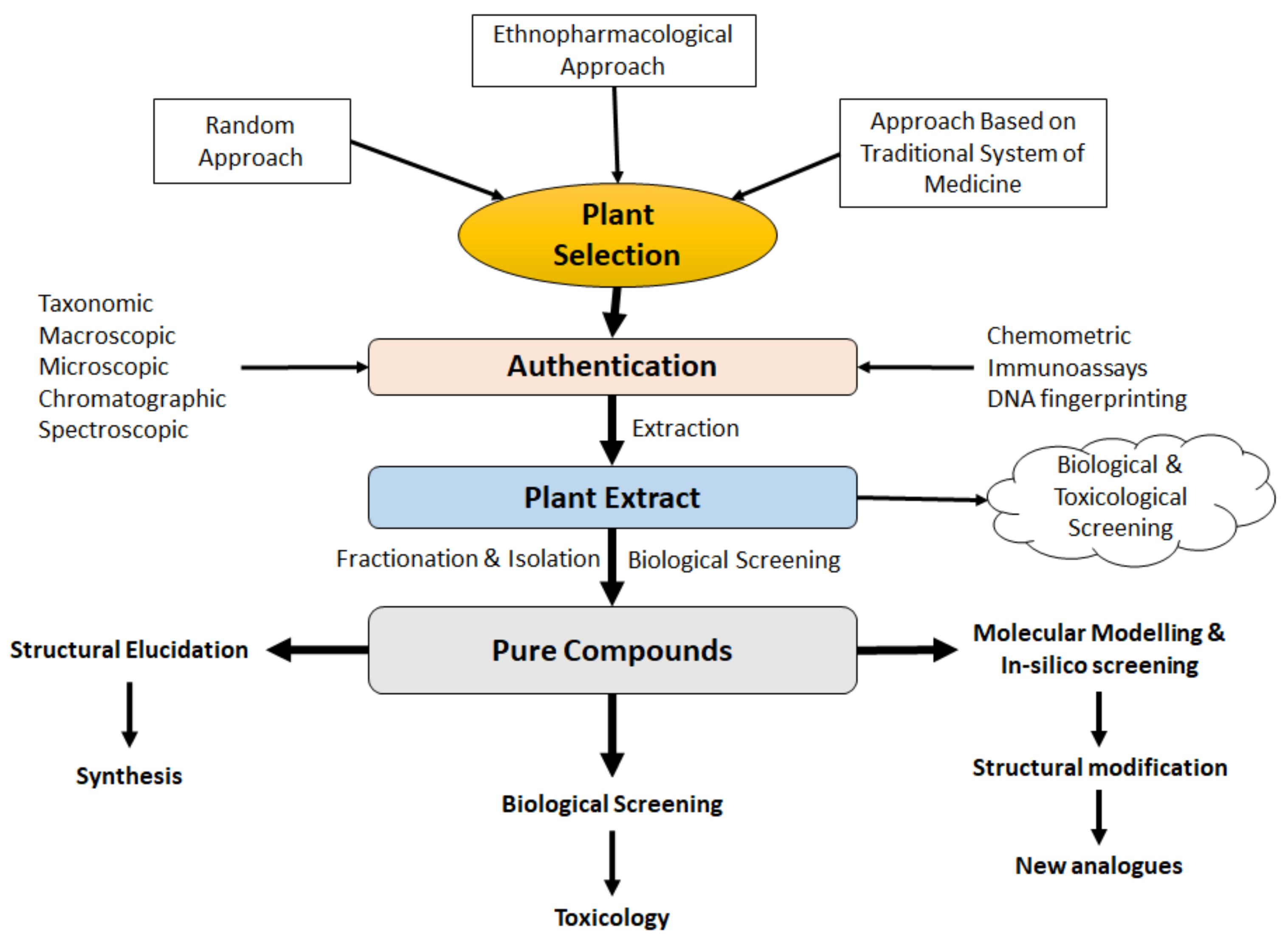
| Name of the Natural Compound | Botanical Source | Chemical Structure | Therapeutic Indication/Activities | Mechanism of Action | References |
|---|---|---|---|---|---|
| Drugs Derived from Plant Sources | |||||
| Arglabin | Artemisia glabella |  | Anti-tumor | Inhibition of farnesyl transferase | [21,22] |
| Artemisinin | Artemisia annua L. |  | Treatment of malaria | Free radical formation that alkylate essential malarial proteins | [23] |
| Cannabidiol | Cannabis sativa L |  | Anti-epileptic, anxiolytic, antipsychotic, and anticancer | Modulation of CB1, CB2, 5HT1A receptors in the CNS | [24] |
| Capsaicin | Capsicum annum L.; C. minimum Mill. | 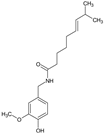 | Chronic pain syndromes such as postherpetic neuralgia and musculoskeletal pain | Activates Transient receptor potential vanilloid 1 (TRPV1) in sensory nerves | [25] |
| Colchicine | Colchicum spp. | 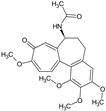 | Gout | Prevents microtubule assembly and hence modulate multiple pro- and anti-inflammatory pathways | [26] |
| Curcumin | Curcuma longa L. (Turmeric) |  | Antioxidant, anti-inflammatory, arthritis, metabolic syndrome and pain | Inhibition of NF-kB; scavenge reactive oxygen and nitrogen species; modulates the activities of GSH, catalase and SOD | [27] |
| Epigallocatechin-3-O-gallate (EGCG) | Camellia sinensis L. (Green tea) | 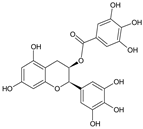 | Anti-viral against a diverse family of DNA and RNA viruses; antibacterial and antifungal activities. Anticancer, anti-inflammatory and anti-diabetic activities | Alter or damage viral particle, primary target is viral membrane; disruption of lipid layer in bacterial cell wall; inhibits dihydrofolate reductase. Modulation of ROS production and inhibition of NF-kB signaling responsible for anticancer activity | [28,29] |
| Galantamine | Galanthus caucasicus Grossh. |  | Dementia associated with Alzheimer’s disease | Reversible acetylcholinesterase inhibitor; modulation nicotinic acetylcholine receptor (nAChRs) | [30] |
| Genistein | Genista tinctoria L. |  | Anticancer, Alzheimer’s disease | Protein-tyrosine kinase inhibition, induction of apoptosis, cell cycle arrest, antimetastatic and antiangiogenic activity, antioxidant | [31] |
| Gossypol | Gossypium hirsutum L. (Cotton plant); Thespesia populnea |  | Anti-infertility/male contraceptive, Anticancer, antiviral, antimicrobial, antioxidant activities | Inhibit sperm production and motility; Bcl-2 inhibition; DNA polymerase and topoisomerase II inhibition; induce apoptosis | [32] |
| Ingenol mebutate | Euphorbia peplus L. |  | Actinic keratosis | Dual mechanism, Inducer of cell death necrosis and local pro-inflammatory response | [33] |
| β-Lapachone | Tabebuia avellanedae (Lapacho tree) |  | Variety of cancers, especially solid tumors, anti-trypanosoma, antimicrobial and antimalarial activities | Anticancer activity through formation of ROS in NQO1-positive cells, topoisomerase inhibition, mTOR pathway modulator | [34,35] |
| Masoprocol | Larrea tridentate |  | Antineoplastic agent used in cancer chemotherapy | 5-Lipoxygenase inhibition | [36] |
| Omacetaxine mepesuccinate (Homoharringtonine) | Cephalotaxus harringtonia; C. fortune | 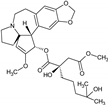 | Anticancer agent; mainly chronic myeloid leukemia (CML) | Protein synthesis inhibition (prevent peptide elongation) | [37] |
| Paclitaxel | Taxus brevifolia Nutt. |  | Cancer chemotherapy | Mitotic inhibitor | [36,38] |
| Podophyllotoxin | Podophyllum emodi Wall. and P. peltatum L. | 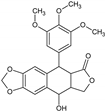 | Antitumor | Polymerization of tubulin resulting in cell cycle arrest and suppress the formation of mitotic spindles microtubules | [39] |
| Quercetin | Many sources including Allium cepa L.; Morus alba; Camellia sinensis; Moringa oleifera; Centella asiatica etc. |  | Antioxidant, anti-inflammatory, anticancer, cardiovascular protection; Alzheimer’s disease; anti-ulcer; antimicrobial; antiallergic | Inhibits cyclooxygenase and lipoxygenase; inhibits platelet aggregation; inhibit gastric secretion and lipid peroxidation; ROS generation and MicroRNA 21 elevation | [40] |
| Resveratrol | Vitis vinifera L |  | Chemopreventive and chemotherapeutic in different types of cancer. Also used as antidiabetic, in cardiovascular complications, metabolic syndromes, antioxidant. | Modulation of multiple molecular pathways involved in cancer and xenobiotic metabolism; reduce oxidative stress and inflammation; cell proliferation arrest; induce apoptosis | [34] |
| Drugs Derived from Microbial Sources | |||||
| Teixobactin | Eleftheria terrace | N-[N-Methyl-D-Phe-Ile-Ser-D-Gln-D-alle-Ile-Ser-]cyclo[D-Thr-Ala-[3-(2-iminoimid-azolidine-4 beta-yl)-Ala-]Ile-] | Antibacterial agent active against various gram-positive bacterial including vacomycin resistant enterococci and methicillin-resistant S. aureus | Inhibition of bacterial cell-wall sybthesis by binging to the synthesis building blocks lipid-II and lipid-III | [41] |
| Lodopyridone | Saccharomonospora sp. |  | Anticancer | Cytotoxic to HCT-116 human colon cancer cells | [42] |
| Salinosporamide A | Salinospora tropica |  | Anticancer | Inhibition of 20S Proteasome | [43] |
| Platensimycin | Streptomyces platensis |  | Antibiotic, active against various Gram-positive bacteria including resistant strains | Inhibition of fatty acid synthesis in cell membrane through inhibition of β-ketoacy synthases I/II (FabF/B) | [44] |
| Platencin | Streptomyces platensis | 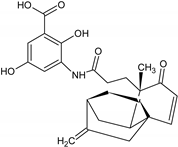 | Antibiotic, active against various Gram-positive bacteria including resistant strains | Inhibition of fatty acid synthesis in cell membrane through inhibition of β-ketoacy synthases I/II (FabF/B) | [44] |
| Cryptophycin | Cyanobacteria Nostoc sp. |  | Anticancer | Inhibiotion of cell division by depletion of microtubule through interaction with tubulin | [45] |
| Daptomycin | Streptomyces roseosporus | - | Systemic and life-threatening infection caused Gram-positive bacteria | Disruption of bacterial cell-membrane function | [46] |
| Retapamulin | Pleurotus mutilins |  | Antibacterial used to treat topical skin infection impetigo | Inhibition of bacterial protein synthesis by binding to 50s ribosome | [47] |
| Ethnopharmacological/Traditional Approach | Random Selection Approach | |
|---|---|---|
| Characteristics |
|
|
| Strengths |
|
|
| Weaknesses/Challenges |
|
|
| Examples |
| 35,000 plant species screened through random selection between 1960 to 1980 leading to discovery of paclitaxel and camptothecin [18]. |
| Screening Models | Strengths | Weaknesses |
|---|---|---|
| In-vivo animal models | Physiological similarities to humans; pathophysiological relevance is high; activity on the level of whole organism and transgenic models may be generated. | Require to manage animal facility; need larger amounts of test samples; ethical consideration; low-throughput; may be species related differences. |
| In-vitro cellular target-based assays | Known molecular target; no need to determine the mechanism of action separately; efficacy of hits at cellular level, high-throughput | Observed efficacy may not be a result of the mechanism originally expected because a drug generally bind at more than one target; may not be able to reflect whole mechanism of the hits; no assurance for in-vivo efficacy; requirement of cell culture facility |
| In-vitro phenotype cell-based assays | Potential to discover new molecular target; medium to high-throughput; efficacy of hits at cellular level | No assurance for in-vivo efficacy; requirement of cell culture facility; identification of molecular target may need great effort; possibility of poor structure activity relationship of hits in the optimization phase |
| In-vitro assays with isolated proteins | No animal or cell culture facilities required; high-throughput screening | Hits may be unable to reach the target for interaction into cells or in-vivo (hits with low bioavailability) |
| In-situ/ex-vivo isolated tissues or organs | Higher-throughput than animal models; good pathophysiological relevance | Lower-throughput than cell-based bioassays; ethical consideration; short life of isolated tissues and organs |
Publisher’s Note: MDPI stays neutral with regard to jurisdictional claims in published maps and institutional affiliations. |
© 2022 by the authors. Licensee MDPI, Basel, Switzerland. This article is an open access article distributed under the terms and conditions of the Creative Commons Attribution (CC BY) license (https://creativecommons.org/licenses/by/4.0/).
Share and Cite
Najmi, A.; Javed, S.A.; Al Bratty, M.; Alhazmi, H.A. Modern Approaches in the Discovery and Development of Plant-Based Natural Products and Their Analogues as Potential Therapeutic Agents. Molecules 2022, 27, 349. https://doi.org/10.3390/molecules27020349
Najmi A, Javed SA, Al Bratty M, Alhazmi HA. Modern Approaches in the Discovery and Development of Plant-Based Natural Products and Their Analogues as Potential Therapeutic Agents. Molecules. 2022; 27(2):349. https://doi.org/10.3390/molecules27020349
Chicago/Turabian StyleNajmi, Asim, Sadique A. Javed, Mohammed Al Bratty, and Hassan A. Alhazmi. 2022. "Modern Approaches in the Discovery and Development of Plant-Based Natural Products and Their Analogues as Potential Therapeutic Agents" Molecules 27, no. 2: 349. https://doi.org/10.3390/molecules27020349
APA StyleNajmi, A., Javed, S. A., Al Bratty, M., & Alhazmi, H. A. (2022). Modern Approaches in the Discovery and Development of Plant-Based Natural Products and Their Analogues as Potential Therapeutic Agents. Molecules, 27(2), 349. https://doi.org/10.3390/molecules27020349








